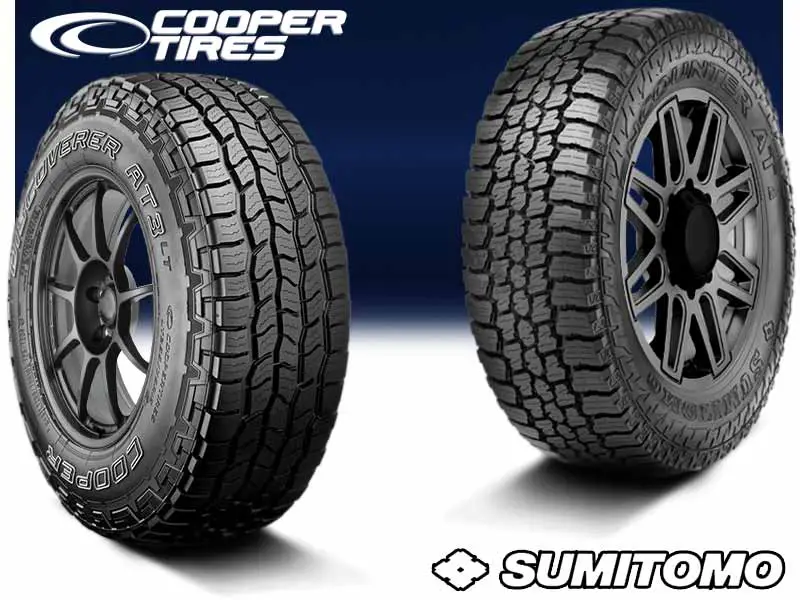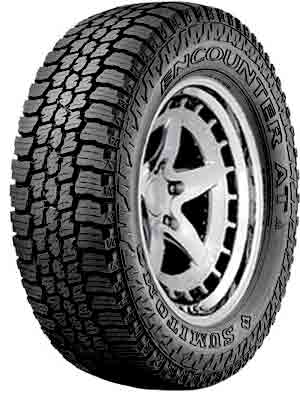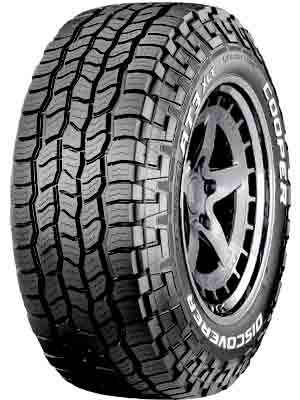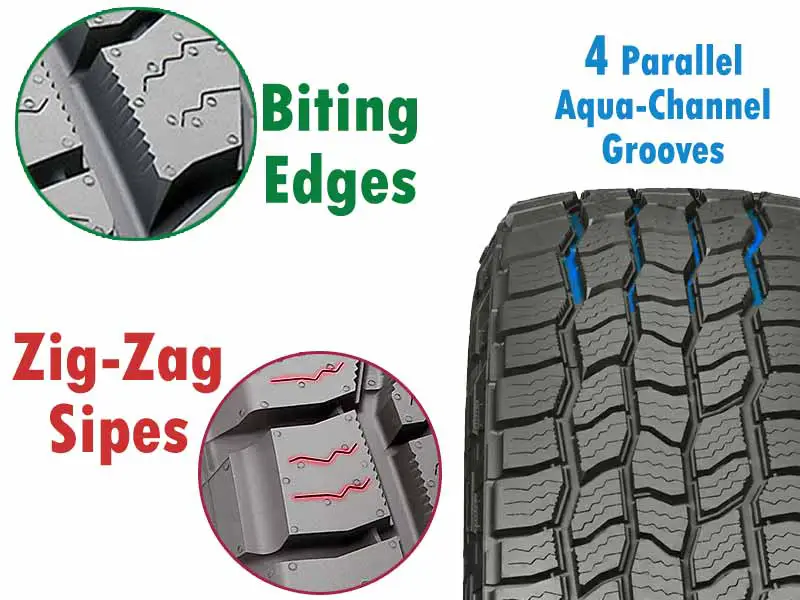Both the Sumitomo Encounter AT and the Cooper Discoverer AT3 are all terrain tire which provide you the best of both worlds (both on and off road). Both tires offer premium all season traction and are especially designed for pick up trucks, SUVs, and crossovers.
The Encounter AT, by Sumitomo (a Japanese brand), is a very nice budget pick, that does not compromise on the quality, the tire offers 3 peak mountain snowflake rating, like the Cooper AT3, and provides a great wet traction (which is the most impressive feature about this tire).

Table of Contents
Tread Pattern (What to Know):
Sumitomo Encounter A/T

Cooper AT3 XLT

The middle of the Sumitomo Encounter AT shows up with actually just 2 unique blocks and they are placed differently to form 3 columns.
The central blocks (highlighted with yellow) have connectors in between, which act as supporting foundations. These blocks are also seen with ramps on their edges, off set sides, notches facing sideways and wave like siping.

The surrounding T shaped blocks which make 2 more rows have slightly different pattern with elongated siping, chamfered edges and notches (which act as traction biters).
All these blocks together make 4 circumferential grooves where the inner 2 are narrower (in comparison to outer).
In case of Cooper Discoverer AT3, although you also see 4 longitudinal aqua channels, and reinforced foundations between the central blocks (which join the blocks in pairs), the tire makes a more sqaured-off kind of pattern.

It also offers more siping in comparison, where all it’s sipes are wave like (this interlocking pattern of sipes is very effective on snow and water).

On shoulders of Cooper Discoverer AT3, the outer margins are staggered while the inner side has snow vices (saw toothed edges) and reinforced foundations.
Also, siping pattern remains same here, as throughout the rest of the tread.
If we look at the shoulders of Sumitomo Encounter AT, they are not serrated like Cooper, but each block is (half) staggered on itself. Also all blocks have traction notches on their sides and wavelike siping (which has a more interlocking design in comparison).

It’s shoulder blocks also join together with connectors in between, (just like the Cooper AT3) and this helps with on road stability and noise.
If we look at the sidewall lugs, both tires provide almost same thickness, where Sumitomo covers a larger surface area (this helps when you pressure down these tires off road to a lower PSI levels).
Dry On Road Traction:
Let’s talk about the dry roads first, here there are two key factors to consider, one is the grip of the tire, and the other is handling/cornering stability.
Both these areas are excelled by Cooper Discoverer AT3, as it offers a more on road oriented design, providing more rubber surface area in contact with the pavement, and stiffer rubber composition (resulting in superior grip).
To improve tire’s dry on road performance, all of it’s blocks are reinforced with foundations underneath, which provide shorter stopping distances, and chamfered edges, which give you handling stability.
The Sumitomo Encounter on the other hand, has wider lateral grooves between the shoulder blocks, and although both tire’s have ridges there, the extra supporting foundations on Cooper AT3 provide better efficacy.
Wet Traction:
Wet performance has 3 main key parts, grip, handling and hydroplaning. Now all these areas are seen better on Sumitomo Encounter AT.
That’s because the tire offers dual siping pattern, which gives it’s tread blocks flexibility. And its already very elastic compared to competitor, as it’s rubber composition include high density silica which keeps the tread softer.
So with softer tread and better siping, the tire has more efficiency to wipe water away.
And although both tires have 4 aqua channels, the Sumitomo provides better lateral grooves connecting them, so more float speeds can be achieved on this tire, making it more resistant to hydroplaning.
Hydroplaning is simply related to how fast a tire cleans off water from it’s grooves, the faster it does, the lesser is left behind for sipes to deal with, that’s why Encounter AT shows better wet traction overall.
Side Note: Sumitomo AT wet performance is also credited to it’s shoulder blocks, and it makes sense, because if you look close enough, blocks there have a very aggressive interlocking design (it’s blocks resembles Falken Wildpeak AT3w a lot, which is one of the premium tires you can get for wet on road traction).
Comfort, Fuel Efficiency, Noise and Wear:
Both fuel economy and wear depend on the tire’s rolling resistance a lot, and in Cooper AT3 its less than competitor.
Although, the tire offers more grip on dry roads, it’s stiffer rubber requires less energy to roll. The Sumitomo Encounter on the other hand, with softer compound and more number of biting edges, consumes more fuel and is more prone to wear.
But the tire excels in terms of comfort, as its high silica density tread which provides softer rubber is able to absorb bumps in a better way.
But in second part of comfort, the noise, there isn’t much difference between both tires, as they offer variable ptich and whisper groove technologies to tackle it.
With variable ptich, the blocks on the tread provide different pitches when air strikes on them (which is what tread noise is). These different frequencies cancel out each other and noise is dampened that way.
The Whisper Groove Technology is a tread feature which is actually Cooper made, but seen on both tires, this refers to the connectors between the shoulder blocks.
As most of the air enters the shoulder (which than hit the tread to make noise), the connectors/ridges restrict it’s flow, reducing the noise levels.
Winter Traction:
Both tires have the 3 peak mountain snowflake rating symbol, which tell us that they are good for snow in terms of acceleration.
But, in terms of braking and handling, both tires show different traction values, where the Sumitomo Encounter AT is slightly better because of a few things.
First, with softer compound that makes sipes flexible, the tire is less prone to get stiffen up with winter’s freezing temperature, that’s why winter tires are so soft.
Second, the tire offers more biters overall, as each block is equipped with traction notches, and although Discoverer AT3 has snow vices too, the combined effect is superior on Sumitomo as the tire provides better snow to snow contact.
The 3pmsfr is actually just an acceleration test, it does not tell you about braking distances or tire’s handling.
Rocky Terrain Traction:
On rocks both tires provide very similar performance. They are not as durable overall but offer same kind of protection.
Both of these tires have 2 ply polyester casing, which comes beneath the 2 steel belts. These steel belts on both tires are then covered with (single-layer) nylon, where on Sumitomo it’s wrapped spirally.
So both tires are are going to be vulnerable from the sidewalls.
But they still feature rubber compound which is chip and cut resistant, so you can take them on gravel without any trouble.
Can these tires handle Mud?
No, these tires are not suitable on mud, as they just simply get packed with it. They don’t offer wide enough channels where the thick mud can pass through.
On mud you want efficient cleaning, otherwise a packed tire loses all it’s traction abilities, that’s why mud to mud contact is slippery.
What’s the Verdict?
Both the Sumitomo Encounter AT and the Cooper Discoverer AT3 although are all terrain tires, they are more on road oriented, as their tread is not aggressive enough to take on rugged off road challenges.
These tires are also light in weight which provides better on road fuel economy, being light has to do with their less durable inner construction, so that also make them susceptible to damage off road.
So, off road, they are not going to be impressive, but on streets, both are great where the Sumitomo Encounter AT shows better wet performance, and Cooper AT3 shows better dry.


